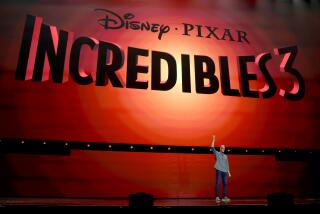The Cutting Edge: COMPUTING / TECHNOLOGY / INNOVATION : Thatâs Edutainment! : Disney Is Magic in the Kingdom of Kidsâ CD-ROM Software
After a decade of half-hearted attempts, the Magic Kingdom is successfully extending its powers into the rapidly emerging realm of interactive computing.
While other Hollywood studios are still having trouble turning their film properties into multimedia profits, Walt Disney Co. has swept in and dominated the fastest-growing segment of the market: the lucrative business for childrenâs âedutainmentâ titles.
In December alone, Disney had the top three best-selling educational software titles, according to Reston, Va.-based researcher PC Data.
Aggressive marketing, a captive audience of families enthralled by Disney characters and a new generation of home computers that play to Disneyâs strengths in music and animation have all combined to make Disney a winner.
âDisney has cracked the code in a substantial way,â says Dennis Cloutier, vice president of sales at Sierra Online, a Disney competitor in the multimedia business. âThey have the distributors, the marketing muscle and the intellectual property, and theyâre willing to commit resources long-term.â
Says Sally Edmark, who founded Edmark, one of the most respected producers of educational titles: âIn the focus groups weâve done, parents say kids love the Disney stuff.â
But analysts and industry observers say Disneyâs next challenge is to learn more about the world of interactivity so it can improve the quality and originality of its titles.
âWhen someone says Disney, I donât know what the quality is going to be,â says Warren Buckleitner, editor of the Ypsilanti, Mich., newsletter Childrenâs Software Revue. âIt could be fabulous, or it could be that they should have kept it on video.â
While Disney is a creative leader when it comes to animation, in the computer market, âthey are treating it as a merchandising venue rather than as an art form,â says Ron Gilbert, co-founder of Humongous Entertainment, a widely respected childrenâs CD-ROM producer.
Disney has yet to make major inroads into other major segments of the CD-ROM software business--notably the PC game business, where the technology is more important than characters in selling titles. While the edutainment market has doubled in the last two years to about $500 million, the CD-ROM and video game business is several times larger.
Still, Disney has startled the industry with its recent success in the educational arena, particularly in light of its weaknesses. In the early 1980s, Disney licensed its characters for video games but refused to invest its own money. The company finally created a separate software division in 1989 and worked with experienced game makers to put out two successful video games on cartridge, Aladdin and The Lion King. But in part because the software division was part of the consumer products division that sells Disney character merchandise, the company never built on its success.
It wasnât until 1994--when Disney Chairman Michael Eisner put his weight behind the CD-ROM business by creating Disney Interactive--that Disney seriously tackled the market. That Christmas, Disney came out with a big-budget CD-ROM based on âThe Lion Kingâ movie.
Unfortunately, there were glitches in the product. Angry parents who could not get the program to work or customer support on the phone flooded the company with complaints. Nevertheless, the product was a breakthrough for the industry, selling 500,000 titles in one year. Until The Lion King, ânobody thought we could break the 150,000 title barrier,â says Gilbert of Humongous.
Disney overhauled its customer service operations and increased product testing to remove glitches. To prevent teary-eyed children and angry parents on Christmas morning, it started including wrapping in the CD-ROM boxes.
âWe told people to open the product and test-drive it before wrapping it up and putting it under the tree,â says Carolyn OâKeefe, a Disney Interactive marketing vice president. Disney also distributed booklets to help parents buy and install software.
To attract customers, Disney sent 6 million mailers to members of Burger Kingâs Kids Club, offering free samples of its CD-ROM titles. The company was also among the first to use television advertising to sell CD-ROMs.
Most important, Disney fully leveraged the strength of its animated films. Each CD-ROM title is centered on a popular Disney film and is narrated by one of the main characters, typically using the same actor or actress for the voice. Children often identify closely the characters on the computer with the films they love, often talking to the characters on the screen.
Disney also uses the marketing power of its animated movies to help sell CD-ROMs. When 20 million copies of the animated movie âThe Aristocatsâ are released next month, they will come with a trailer promoting the CD-ROM version of âToy Storyâ that will be released at the same time. The âToy Storyâ CD-ROM, which will be made by Pixar Studios, the high-tech company that produced the film, is also expected to be a major hit.
Later this fall, when Disney releases a new, âlive-actionâ version of â101 Dalmatiansâ that features real dogs, Disney will simultaneously release an animated CD-ROM version of the product.
But when it comes to delivering what the industry likes to call a quality âinteractive experience,â Disney contracts the programming to independent studios--with uneven results. While The Lion King Activity Center, developed with Gryphon Software Corp., is widely admired, Disneyâs Animated Storybook series, developed with Media Station, is seen as a mere imitation of Broderbundâs Living Books format.
Buckleitner says Disneyâs greatest strength is also the greatest weakness of its titles: âSince the first priority is on the characters, the stuff looks great but the interactivity can suffer.â
The new games offered are often hard to use, or flawed. Try to hit the left-hand corner target on the easiest level of the archer game in the Pocahontas title, for example. It appears to be impossible.
âThere are things 6-year-olds can do that adults canât,â explains Steve Fields, head of Disney Interactiveâs edutainment group, in response to a question about the problem. A woman on Disneyâs customer service line is more helpful: âI had the same problem with that game during training,â she says. âAim to the right of the target.â
Disneyâs problems with its games are typical of Hollywood studios that get into the computer game business.
âThe studios repeatedly underestimate the importance of game play,â says Ralph Giuffre, who recently left Time Warner Interactive to head marketing and licensing efforts at Seattle-based Humongous.
When Sony filmed the movie âJohnny Mnemonic,â it took extra shots for its CD-ROM version of the film. The title did poorly. Paramount Interactiveâs Mighty Morphin Power Rangers game was briefly popular, but sales quickly dropped off because of poor game play. Universal Interactiveâs Jurassic Park game for the Sega system was also a failure.
Where a Hollywood character has become part of a successful game, it has typically been licensed by a gaming company. Acclaim Entertainment licensed Batman for a popular video game, for example.
Disney succeeded in spite of the problems with its games because of the extraordinary popularity of its characters and because the parents who buy the products trust the Disney name--and arenât necessarily looking for leading-edge technology.
But observers say that if Disney is to succeed long-term, it must bring into top management people who understand interactive games.
âWe have characters people relate to; our challenge is to create truly interactive products,â acknowledges Fields of Disney Interactive. He says the unitâs education division already has 125 people and continues to expand. âWeâre spending enormous amounts of money to make sure there is a unique experience.â
The company will release 12 titles this year, including in the âcreativityâ category that allows kids to draw, write or animate characters; multimedia references; a science title; and an ABC skills title.
Says Fields: âThereâs a strong corporate commitment to becoming a strong player in this category.â
(BEGIN TEXT OF INFOBOX / INFOGRAPHIC)
The Mouse on Top
Disney was No. 1 in market share for educational CD-ROMs in December, based on units:
Disney: 13.2%
Broderbund/Living Books: 12%
Davidson: 11.4%
Learning Co.: 9.5%
MECC: 5.6%
Microsoft: 5%
Other: 43.3%
Source: PC Data






